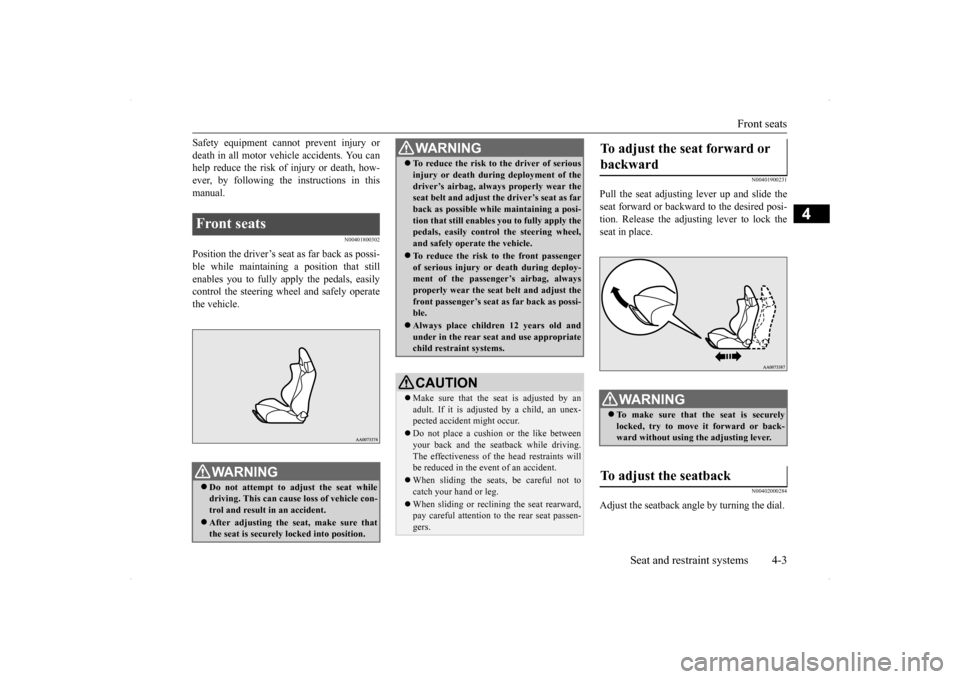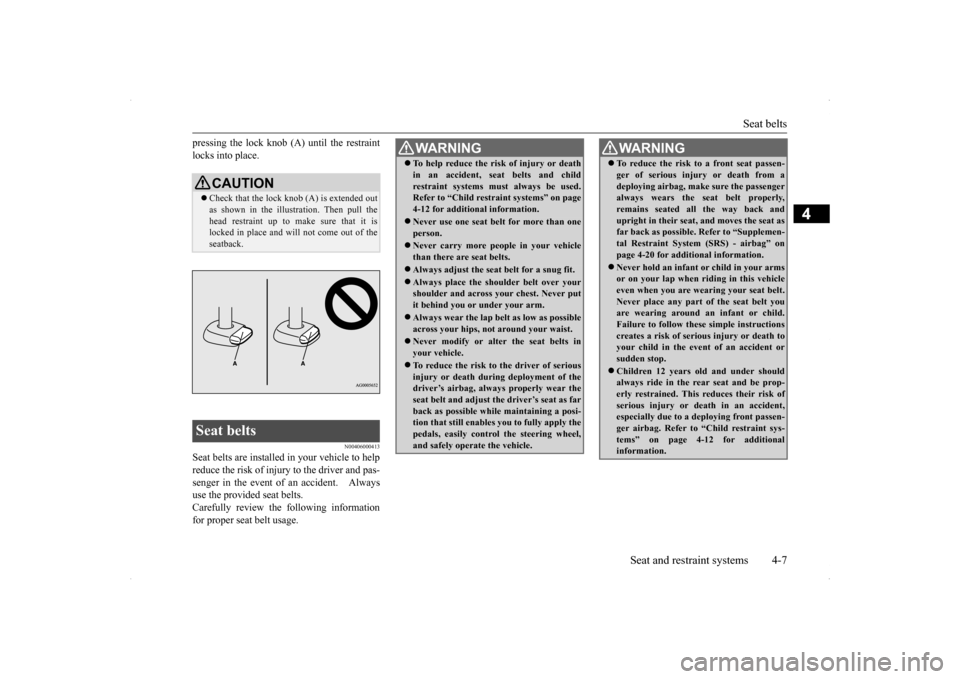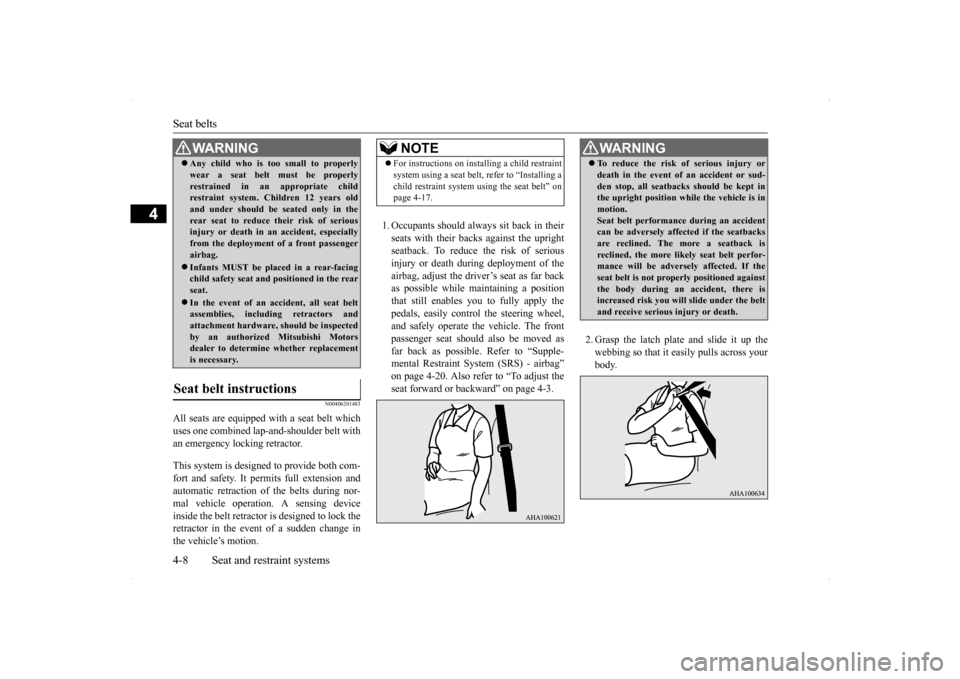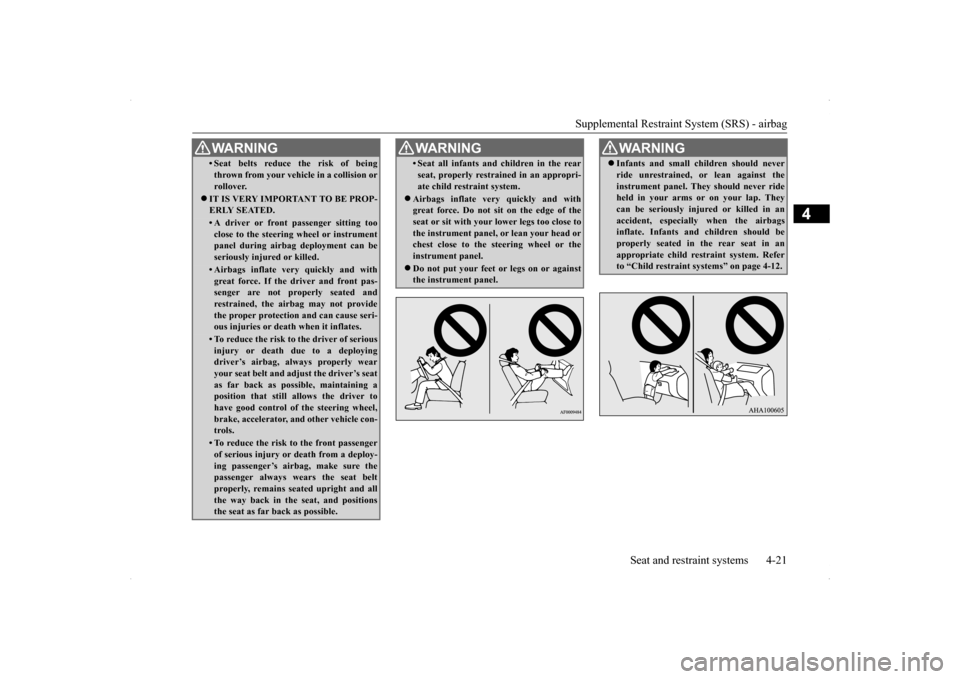2014 MITSUBISHI LANCER EVOLUTION steering
[x] Cancel search: steeringPage 3 of 338

Instruments and controls (Driver’s area) 1-1
1
Overview
N00100202515
Instruments and controls (Driver’s area)
Instrument cluster P.5-89
Sportronic steering wheel paddle shifter (if so equipped) P.5-66
Multi-information meter switch P.5-92 Combination headlights and dimmer switch P.5-125Turn signal lever P.5-131 Front fog light switch P.5-131
Wiper and washer switch P.5-132
Active stability control OFF switch P.5-77
Cruise control switches P. 5 - 8 1
Headlights leveling switch (if so equipped) P.5-130
Ignition switch P.5-15, 5-22, 5-50
Fuses P.9-23
Engine hood release lever P.9-3
Supplemental restraint system - air- bag (for driver’s seat) P.4-20, 4-26Horn switch P.5-137
Steering wheel tilt lock lever P.5-47
Supplemental restraint system
- driver’s knee airbag
P.4-26
Bluetooth
® 2.0 interface P.5-137
Steering wheel audio remote control switches Refer to the separa
ted owner’s manual
BK0200800US.bo
ok 1 ページ 2013年2月14日 木曜日 午後2時28分
Page 14 of 338

If this problem occurs...
Quick index 2-3
2
N00200901893
If this problem occurs...
Problem
Do this
Ref. page
Cannot turn the key. (When using a key to start the engine)
When using a key to start the engine Will not turn from “LOCK” to “ACC”. Turn the key while turning the steering wheel in either direction.
P.5-51, 5-52
Will not turn from “ACC” to “LOCK”. Vehicles with Twin Clutch SST: Check the position of the gearshift lever.The key cannot be removed unless the gearshif
t lever is set to the “P” (PARK) position.
Vehicles with manual transaxle: Place the key at the “ACC” position. Push the key in and turn it.
(When using the F.A.S.T.-key to start the engine)
When using the F.A.S.T.-key to start the engine Will not turn from “LOCK (PUSH OFF)” to “ACC”.Push the ignition switch again, turn the steering
wheel in both directions and then turn the
ignition switch. Will not turn from “ACC” to “LOCK”. Vehicles with Twin Clutch SST:Check whether the gearshift lever is set to the “P” (PARK) position. Vehicles with manual transaxle: Place the ignition switch at the “ACC” position.
Push the ignition switch in and turn it.
P. 5 - 1 1
The F.A.S.T.-key does not oper- ate. (for vehicles equipped with the F. A . S . T. - k e y )
Use the emergency key to lock and unlock the doors and start the engine. P.5-21
BK0200800US.bo
ok 3 ページ 2013年2月14日 木曜日 午後2時28分
Page 28 of 338

Front seats
Seat and restraint systems 4-3
4
Safety equipment cannot prevent injury or death in all motor vehicle accidents. You can help reduce the risk of injury or death, how- ever, by following the
instructions in this
manual.
N00401800302
Position the driver’s seat
as far back as possi-
ble while maintaining a position that stillenables you to fully apply the pedals, easily control the steering wheel and safely operate the vehicle.
N00401900231
Pull the seat adjusting lever up and slide theseat forward or backward to the desired posi- tion. Release the adjusting lever to lock the seat in place.
N00402000284
Adjust the seatback angle by turning the dial.
Front seats
WA R N I N G Do not attempt to adjust the seat while driving. This can cause loss of vehicle con- trol and result in an accident. After adjusting the seat, make sure that the seat is securely locked into position.
�ç
To reduce the risk to the driver of serious injury or death during deployment of the driver’s airbag, always properly wear the seat belt and adjust th
e driver’s seat as far
back as possible while maintaining a posi-tion that still enables
you to fully apply the
pedals, easily control the steering wheel, and safely operate the vehicle. To reduce the risk to the front passenger of serious injury or death during deploy-ment of the passenger’s airbag, always properly wear the seat belt and adjust the front passenger’s seat as far back as possi-ble. Always place children 12 years old and under in the rear seat and use appropriate child restraint systems.CAUTION Make sure that the seat is adjusted by an adult. If it is adjusted by a child, an unex-pected accident might occur. Do not place a cushion or the like between your back and the seatback while driving. The effectiveness of the head restraints will be reduced in the event of an accident. When sliding the seats, be careful not to catch your hand or leg. When sliding or reclining the seat rearward, pay careful attention to the rear seat passen- gers.WA R N I N G
To adjust the seat forward or backward
WA R N I N G To make sure that the seat is securely locked, try to move it forward or back- ward without using the adjusting lever.
To adjust the seatback �ç
BK0200800US.bo
ok 3 ページ 2013年2月14日 木曜日 午後2時28分
Page 32 of 338

Seat belts
Seat and restraint systems 4-7
4
pressing the lock knob (A) until the restraint locks into place.
N00406000413
Seat belts are installed in your vehicle to helpreduce the risk of injury to the driver and pas-senger in the event of an accident. Always use the provided seat belts. Carefully review the following informationfor proper seat belt usage.
CAUTION Check that the lock knob (A) is extended out as shown in the illustration. Then pull the head restraint up to make sure that it islocked in place and will not come out of the seatback.
Seat belts
WA R N I N G To help reduce the risk of injury or death in an accident, seat belts and child restraint systems must always be used. Refer to “Child restraint systems” on page 4-12 for additional information. Never use one seat belt for more than one person. Never carry more people in your vehicle than there are seat belts. Always adjust the seat belt for a snug fit.Always place the shoulder belt over your shoulder and across your chest. Never put it behind you or under your arm. Always wear the lap belt as low as possible across your hips, not around your waist. Never modify or alter the seat belts in your vehicle. To reduce the risk to the driver of serious injury or death during deployment of thedriver’s airbag, always properly wear the seat belt and adjust th
e driver’s seat as far
back as possible while maintaining a posi-tion that still enables
you to fully apply the
pedals, easily control the steering wheel, and safely operate the vehicle.
To reduce the risk to a front seat passen- ger of serious injury or death from a deploying airbag, make sure the passenger always wears the seat belt properly, remains seated all the way back andupright in their seat, and moves the seat as far back as possible. Refer to “Supplemen- tal Restraint System (SRS) - airbag” onpage 4-20 for additional information. Never hold an infant or child in your arms or on your lap when riding in this vehicle even when you are wearing your seat belt. Never place any part of the seat belt youare wearing around an infant or child. Failure to follow these simple instructions creates a risk of serious injury or death toyour child in the event of an accident or sudden stop. Children 12 years old and under should always ride in the rear seat and be prop- erly restrained. This reduces their risk ofserious injury or death in an accident, especially due to a deploying front passen- ger airbag. Refer to “Child restraint sys-tems” on page 4-12 for additional information.WA R N I N G
BK0200800US.bo
ok 7 ページ 2013年2月14日 木曜日 午後2時28分
Page 33 of 338

Seat belts 4-8 Seat and restraint systems
4
N00406201483
All seats are equipped with a seat belt which uses one combined lap-and-shoulder belt withan emergency locking retractor. This system is designed to provide both com- fort and safety. It permits full extension and automatic retraction of the belts during nor-mal vehicle operation. A sensing device inside the belt retractor is designed to lock the retractor in the event of a sudden change inthe vehicle’s motion.
1. Occupants should always sit back in their seats with their backs against the upright seatback. To reduce the risk of seriousinjury or death during deployment of theairbag, adjust the driver’s seat as far back as possible while maintaining a position that still enables you to fully apply thepedals, easily control the steering wheel, and safely operate the vehicle. The front passenger seat should also be moved asfar back as possible. Refer to “Supple- mental Restraint System (SRS) - airbag” on page 4-20. Also refer to “To adjust theseat forward or backward” on page 4-3.
2. Grasp the latch plate and slide it up the webbing so that it easily pulls across yourbody.
Any child who is too small to properly wear a seat belt must be properly restrained in an appropriate child restraint system. Children 12 years old and under should be seated only in therear seat to reduce their risk of serious injury or death in an accident, especially from the deployment of a front passengerairbag. Infants MUST be placed in a rear-facing child safety seat and positioned in the rear seat. In the event of an accident, all seat belt assemblies, including retractors and attachment hardware, should be inspectedby an authorized Mitsubishi Motors dealer to determine whether replacement is necessary.
Seat belt instructions
WA R N I N G
NOTE
For instructions on installing a child restraint system using a seat belt, refer to “Installing a child restraint system using the seat belt” on page 4-17.
WA R N I N G To reduce the risk of serious injury or death in the event of an accident or sud- den stop, all seatbacks should be kept in the upright position while the vehicle is in motion.Seat belt performance during an accident can be adversely affected if the seatbacks are reclined. The more a seatback isreclined, the more likely seat belt perfor- mance will be adversely affected. If the seat belt is not properly positioned againstthe body during an accident, there is increased risk you will slide under the belt and receive serious injury or death.
BK0200800US.bo
ok 8 ページ 2013年2月14日 木曜日 午後2時28分
Page 46 of 338

Supplemental Restraint System (SRS) - airbag
Seat and restraint systems 4-21
4
• Seat belts reduce the risk of being thrown from your vehicle in a collision or rollover.
IT IS VERY IMPORTANT TO BE PROP- ERLY SEATED.• A driver or front passenger sitting tooclose to the steering wheel or instrument panel during airbag deployment can be seriously injured or killed.• Airbags inflate very quickly and withgreat force. If the driver and front pas-senger are not properly seated and restrained, the airbag may not provide the proper protection and can cause seri-ous injuries or death when it inflates.• To reduce the risk to the driver of seriousinjury or death due to a deploying driver’s airbag, always properly wear your seat belt and adjust the driver’s seatas far back as possible, maintaining a position that still allows the driver to have good control of the steering wheel,brake, accelerator, and other vehicle con- trols.• To reduce the risk to the front passengerof serious injury or death from a deploy- ing passenger’s airbag, make sure the passenger always wears the seat belt properly, remains seated upright and allthe way back in the seat, and positions the seat as far back as possible. WA R N I N G
• Seat all infants and children in the rearseat, properly restrained in an appropri- ate child restraint system.
Airbags inflate very quickly and with great force. Do not sit on the edge of the seat or sit with your lower legs too close to the instrument panel, or lean your head orchest close to the steering wheel or the instrument panel. Do not put your feet or legs on or against the instrument panel.WA R N I N G
WA R N I N G Infants and small children should never ride unrestrained, or lean against the instrument panel. They should never ride held in your arms or on your lap. They can be seriously injured or killed in anaccident, especially when the airbags inflate. Infants and children should be properly seated in the rear seat in anappropriate child restraint system. Refer to “Child restraint systems” on page 4-12.
BK0200800US.bo
ok 21 ページ 2013年2月14日 木曜日 午後2時28分
Page 51 of 338

Supplemental Restraint System (SRS) - airbag 4-26 Seat and restraint systems
4
Warning display If there is an error in the system, the warning light will come on and the warning display will appear on the information screen in themulti-information display. Under normal conditions, the warning light comes on when the ignition switch is turnedto the “ON” position and goes off a few sec- onds later. The warning light will also come on andremain on when the SRS airbags and the seat belt pre-tensioner system have been acti- vated.The warning light/display is used for both SRS airbag warnings and seat belt pre-ten- sioner system warnings.
N00407900028
The driver’s airbag is located under the pad- ded cover in the middle of the steering wheel. The front passenger’s airbag is contained inthe instrument panel above the glove com- partment. The driver’s airbag and the front passenger’s airbag are designed to deploy atthe same time. However, the front passen- ger’s airbag does not deploy when the front passenger seat is not occupied or when theweight sensor in the front passenger seat senses a weight on the seat of less than approximately 66 pounds (30 kg).
N00404500023
The driver’s knee airbag
is located under the
steering wheel. The driver’s knee airbag isdesigned to deploy at the same time as the driver’s front airbag.
WA R N I N G There may be a system error if the warn- ing light/display appears as indicated. Insuch cases, an SRS airbag or a seat belt pre-tensioner system may not function properly in a collision. Have your vehiclechecked by an authorized Mitsubishi Motors dealer:
• Even when the ignition switch is in the“ON” position, the warning light does not come on or it remains on a few sec- onds later• When warning light comes on while driv-ing• When warning display appears whiledriving
Driver’s and passenger’s front airbag system
WA R N I N G
Driver’s knee airbag system Driver Front passenger
BK0200800US.bo
ok 26 ページ 2013年2月14日 木曜日 午後2時28分
Page 55 of 338

Supplemental Restraint System (SRS) - airbag 4-30 Seat and restraint systems
4
WA R N I N G Do not attach anything to the steering wheel’s padded cover, such as trim mate- rial, badges, etc. These could strike and injure an occupant if the airbag inflates. Do not set anything on, or attach anything to, the instrument panel above the glove compartment. Such items could strike andinjure an occupant if the airbag inflates. WA R N I N G Do not attach accessories to, or put them in front of, the windshield. They could restrict the airbag inflation, or strike andinjure an occupant, when the airbag inflates.
Do not attach additional keys or accesso- ries (hard, pointed or heavy objects) to the ignition key. Such objects could prevent the driver’s knee airbag from inflating normally or could be propelled to causeserious injury if the airbag inflates. Do not attach accessories to the lower por- tion of the driver’s side instrument panel. Such objects could prevent the driver’s knee airbag from inflating normally orcould be propelled to cause serious injury if the airbag inflates.WA R N I N G Do not attempt to remove, install, disas- semble or repair the SRS airbags.WA R N I N G
Do not place objects, such as packages or pets, between the airbags and the driver or the front passenger. Such objects can adversely affect airbag performance, or cause serious injury or death when theairbag deploys. Immediately after airbag inflation, some parts of the airbag system will be hot. Do not touch them. You could be burned. The airbag system is designed to work only once. After the airbags deploy, they will not work again. They must promptlybe replaced and the entire airbag system must be inspected by an authorized Mit- subishi Motors dealer.WA R N I N G
BK0200800US.bo
ok 30 ページ 2013年2月14日 木曜日 午後2時28分